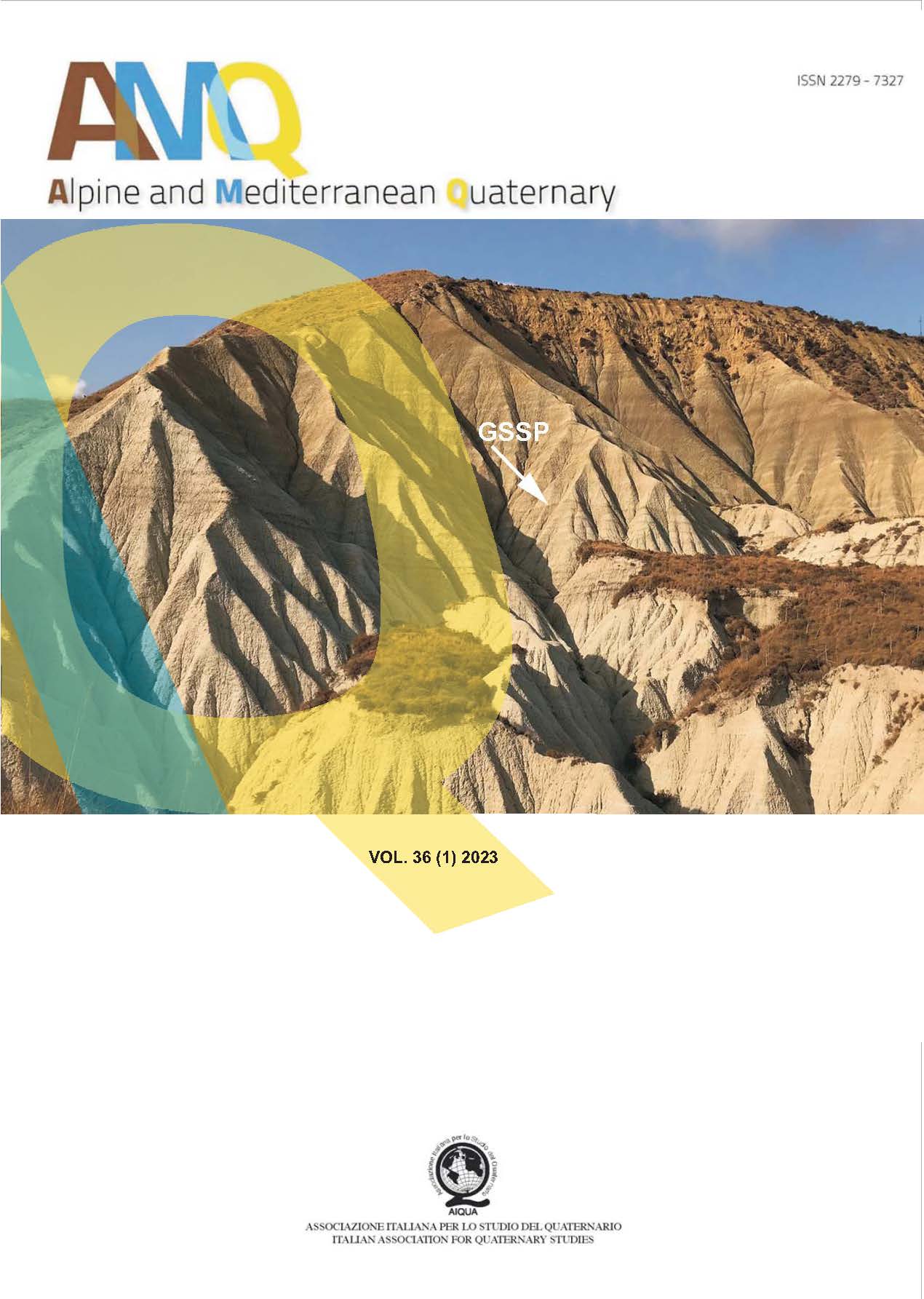INTRODUCTION TO QUATERNARY STUDIES IN ITALY: FROM ARDUINO TO THE FIRST HALF OF THE PAST CENTURY
Main Article Content
Abstract
A summary of the origin and development of Quaternary studies in Italy since the 18th to mid 20th century is presented, focussing on marine sediments stratigraphy, continental glacial deposits, vertebrate paleontology, paleobotany, and paleoanthropology. The history of the Quaternary sciences in Italy is also figured in a timeline of main milestones. The marine sediments, well exposed in Southern Italy, Sicily and Sardinia, had an important role in the development of Quaternary stratigraphy since Lyell in 1833 introduced the “Newer Pliocene”, then renamed Pleistocene. Several marine stages were defined in Italy, Sicilian by Doderline in 1872, Calabrian by Gignoux in 1910, Tyrrhenian by Issel in 1914, Milazzian by Deperet in 1918 and other later on. A scientific debate on the Plio-Pleistocene boundary started with the 18th International Geological Congress in London when It was established that it should be placed «at the horizon of the first indication of climatic deterioration in the Italian Neogene succession” on the base of changes in marine faunas. The continental deposits, presently attributed to the Quaternary, were described and mapped as “alluvial” and “diluvial terraines” until the seventies of the 19th century. Glacigenic deposits were clearly recognized and described in Italy by Martins and Gastaldi in 1850 at the foot of the Western Alps and, in the following decade, by De Mortillet, Omboni and others at the foot of the Central and Eastern Alps. In the last decades of the 19th century Taramelli, Sacco, and Cozzaglio, started to distinguish the evidence of more than one glaciation. Since the publication of Penck & Brückner’s volumes in 1909, the four-glaciation scheme was generally adopted. The past presence of glaciers on the Apuan Alps and the Apennines was first recognized in the latest 19th century. Subsequently, more than hundred Pleistocene glaciers were identified and attributed to the Würm glaciation. The paleobotanical identity of the Quaternary was first pointed by Reboul in 1833, as “characterized by animal and plant species similar to modern living ones at the same site”. Brongniart, Sternberg and Balsamo-Crivelli first classified plant macrofossils species, provided timelines, and compared the modern forms according to the Linnean system. By the end of 19th century the aliquot of extinct and eradicated plant species in N-Italy was stepped through the Pliocene, Quaternary interglacial and the postglacial periods (Sordelli). The excavating peats at onset 19th century suggested that the macrofossil record could be organized on a robust stratigraphical base. In 1931-1932 the introduction of palynology in Italy marked the initial development of microbotanical stratigraphy and its application to vegetation, climate history and interactions with prehistoric civilizations. Since the Renaissance, the remains of Quaternary terrestrial mammals have caught the attention of collectors and scholars when the collection of fossils from the Upper Valdarno was created by Ferdinando I de’ Medici and Andrea Cesalpino reported the finding of elephant bones at San Giovanni Valdarno. By the end of the 18th and beginning of the 19th centuries, several new species were created from the mammalian remains primarily found in the Tuscany basins, and various geologists and naturalists contributed to the knowledge of the Pleistocene deposits and their mammal fossil record in northern, central (e.g. in the Roman Basin), and southern Italy, as well as in Sicily and Sardinia, where a number of new endemic species were discovered. In 1865 Pareto proposed the Villafranchian Stage for the sequence of fluvial and lacustrine sediments of Villafranca d’Asti (Piedmont). The comparison of the mammalian fauna of Villafranca with other Late Pliocene-Early Pleistocene faunal assemblages from Italy, led successively to the definition of the “Villafranchian European Land Mammal Age”. Lastly, a brief outline of the beginnings of paleoanthropological research and the noteworthy Paleolithic human remains discovered in Italy until the first half of the 20th century is given.
Article Details
Issue
Section

This work is licensed under a Creative Commons Attribution-NonCommercial-NoDerivatives 4.0 International License.
The Author grants usage rights to others using an open license (Creative Commons or equivalent) allowing for immediate free access to the work and permitting any user to read, download, copy, distribute, print, search, or link to the full texts of articles, crawl them for indexing, pass them as data to software, or use them for any other lawful purpose.

